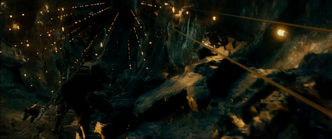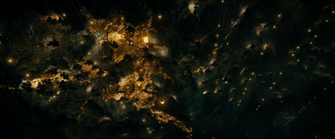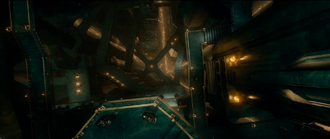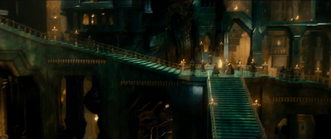The Lonely Mountain, or "Erebor" was a mountain and dwarven city, It was, for the latter half of the Third Age, the greatest city in Middle-earth.
It was located northeast of Rhovanion, and was the source of the River Running.
The mountain was named "Erebor" in Sindarin.
History

Erebor
Years of the Trees and First Age
Durin's Folk discovered mineral wealth of the Lonely Mountain somely Mountain and the colony became the ancestral home of the King under the Mountain. By TA 1999, it had become a Dwarven stronghold, where the Dwarves became a numerous and prosperous people. In this time, the Dwarves became very rich and amassed a large amount of gold and treasure which included the jewel known as the Arkenstone. Thrain I used the Arkenstone as a symbol of his rule, and his sons and grandsons under him who were to follow.
For two-hundred and eleven years the kingdom advanced, expanded, prospered, and endured until Thorin I abandoned it to join his kin in the Grey Mountains, and the Lonely Mountain was abandoned for three-hundred and eighty years. However, the Dwarves of the Grey Mountains began experiencing attacks by the dragons that still lived in those mountains, and became embroiled in a costly war against them, forcing the Dwarves to abandon the Grey Mountains in TA 2590. The Dwarves went their separate ways with Grór and his followers settling in the Iron Hills and Thrór and his followers settling in the Lonely Mountain.
Under Siege
While Thorin Oakenshield was out hunting one day in TA 2770, Smaug came from the mountains and invaded the Lonely Mountain, hoarding all its wealth for himself. Thráin II and several companions escaped by a secret door. For many years thereafter the Dwarves lived in exile in the Blue Mountains until, by a seemingly chance meeting, Gandalf the Grey met Thorin Oakenshield and together they planned to reclaim the mountain. This is told in detail in The Quest of Erebor and described by Tolkien's song, "Far Over the Misty Mountains Cold".
The Quest for Erebor
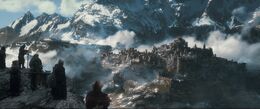
The Dwarves overlooking the Lonely Mountain and the city of Dale
In TA 2941, Bilbo Baggins and Thorin's company traveled to the Lonely Mountain to regain the treasure Smaug had stolen. Set into the side of the mountain was a secret door, five feet high and wide enough for three to walk through abreast. Gandalf had managed to obtain the door's key, which fit a key hole which could be found only when the setting sun and the last moon of autumn (also known as Durin's Day) were in the sky would the light shine upon the keyhole. As told by Tolkien in The Hobbit, it took many days to find the door, and luckily for Thorin and Company they did not arrive on Durin's day so they had plenty of time to enter the mountain.
Smaug was eventually slain, shot out of the sky by a well-aimed arrow to his only weak spot by Bard the Bowman, a man of Laketown, he was a descendant of the king of Dale Girion, who later became king of the Men in the area known as Dale adjoining the Lonely Mountain. Thorin thus reclaimed the mountain, but the Elves of Mirkwood and Men of Lake-town claimed a part of the treasure, which Thorin refused to share. Dáin II Ironfoot came to the aid of his cousin Thorin, and the three Free Peoples almost did battle with one another, but then Orcs attacked and the Dwarves, elves, and men joined ranks together with the eagles against the Orcs, in what became known as the Battle of the Five Armies. During the battle Thorin was mortally injured, and the titles King under the Mountain and King of Durin's Folk passed to Dáin.
War of the Ring
Battle of Dale
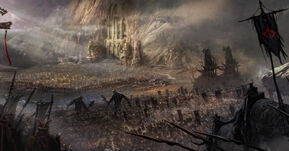
Sauron forces preparing to attack Erebor
The demise of Smaug was not to be the last of Lonely Mountain's many troubles. In TA 3019 on the 17th of March, a horde of Easterling soldiers from Rhûn swarmed over the Redwater river, opening up a second front in the northern theater of the War of the Ring. The sheer force of the feared and renowned Easterlings crushed the Men of Dale and routed their forces, which had to rally back to the protection of the Lonely Mountain.

King Dáin and king Brand ready to defend their kingdoms
The Dwarves and Men fought a pitched battle against the invaders, in which King Dain and The king of Dale at the time were killed, eventually emerging victorious over their opponents. The impenetrable gates and walls of the Lonely Mountain, furnished and extensively worked with advanced, complex and intricate Dwarven stonework, defense planning and smith-work, easily withstood the siege equipment of the Easterlings. The Lonely Mountain itself was a key strong-point and gave its defenders great tactical leverage against the attackers, being able to shoot arrows and fling stones down below in reprisal. The many years invested in improving the Lonely
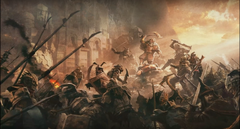
The last resistance against the forces of Sauron
Mountain's defences had paid off, and the defenders outlasted the Easterlings in the siege. The Easterlings then withdrew, suffering disproportionate casualties because of their botched campaign and their difficulty in combating the Dwarven technology, weapons, armor and defenses.
Fourth Age
The Lonely Mountain was a site of battle during the War of the Ring. Dáin was killed during the War of the Ring, and was succeeded by his son Thorin III Stonehelm, who ruled well into the Fourth Age. During this time, Dwarves from the Lonely Mountain helped rebuild cities in Gondor and the fortress of Helm's Deep, and some went to the newly established Dwarven colony in the Glittering Caves where Gimli was lord.
Portrayals in adaptations
The Hobbit film trilogy
Peter Jackson's The Hobbit trilogy (2012-2014) featured computer-generated shots of the Lonely Mountain, Dale, and other Dwarven cities.
Translations around the World
| Foreign Language | Translated name |
|---|---|
| Afrikaans | Eensame Berg |
| Albanian | Mal i Vetmuar |
| Arabic | الجبل الوحيد |
| Armenian | միայնակ լեռնային |
| Azerbaijani | Tənha Dağ |
| Belarusian Cyrillic | Aдзінокая Гара |
| Bengali | লোনলি মাউন্টেন |
| Bosnian | Usamljena planina |
| Bulgarian Cyrillic | Самотна планина |
| Burmese | အထီးကျန်တောင်ကြီးတောင်ငယ် |
| Cambodian | ភ្នំឯកោ |
| Cebuano | Mingaw nga bukid |
| Chinese (Continental) | 孤山 |
| Chinese (Hong Kong) | 孤山 |
| Catalan | Muntanya Solitària |
| Croatian | Usamljena planina |
| Czech | Osamělá Hora |
| Danish | Ensomme Bjerg |
| Dutch (Netherlands And Belgian) | Eenzame Berg |
| Esperanto | Soleca Monto |
| Estonian | Üksildane Mägi |
| Filipino | Nag-iisang Bundok |
| Finnish | Yksinäinen vuori |
| French | Mont Solitaire |
| Frisian | Iensume Berch |
| Galician | Montaña Solitaria |
| German | Einsamer Berg |
| Greek | Μοναχικό όρος |
| Gujarati | લોન્લી માઉન્ટેન |
| Hawaiian | Mehameha Mauna |
| Hebrew | הר בודד |
| Japanese | 孤独な山 |
| Spanish | Montaña Solitaria |
| Georgian | განმარტოებული მთა |
| Haitian Creole | Mòn sèl |
| Hindi | सुुनसान पर्वत |
| Hmong | Roob kho siab |
| Hungarian | Magányos Hegy |
| Icelandic | Einmanna fjall |
| Indonesian | Gunung sendiri ? |
| Irish Gaelic | Sliabh Uaigneach |
| Italian | Montagna Solitaria |
| Kannada | ಲೋನ್ಲಿ ಮೌಂಟೇನ್ |
| Kazakh | жалғыз тау (Cyrillic) Jalğız taw (Latin) |
| Korean | 외로운 산/에레보르 |
| Kurdish | Çiya bi tenę (Kurmanji Kurdish) |
| Kyrgyz Cyrillic | жалгыз тоо |
| Laotian | ພູເຂົາເປົ່າປ່ຽວດຽວດາຍ |
| Latin | Montem Sola |
| Latvian | Vientuļais Kalns |
| Lithuanian | Vienišasis Kalnas |
| Macedonian Cyrillic | Осамена Планина |
| Maori | Maunga Mokemoke |
| Malay | Gunung Sepi |
| Maltese | Solitarju Muntanja ? |
| Marathi | एकाकी डोंगरावर |
| Mongolian Cyrillic | ганцаардаж уулын |
| Nepalese | एक्लो पहाड |
| Norwegian | Ensomfjellet |
| Persian | کوه تنهایی |
| Polish | Samotna Góra |
| Portuguese (Brazil and Portugal) | Montanha Solitária |
| Punjabi | ਇਕੱਲੇ ਪਹਾੜੀ |
| Romanian | Muntele Singuratic |
| Romansh | Muntogna Solitari |
| Russian | Одинокая Гора |
| Scottish Gaelic | Aonaranach Bheinn |
| Serbian | Усамљена Планина (Cyrillic) Usamljena Planina (Latin) |
| Slovenian | Osamljena Gora |
| Slovak | Osamelá Hora |
| Shona | Shurikirwa Gomo |
| Sindhi | اڪيلو جبل |
| Sinhalese | හුදකලා ගිරිය |
| Somalian | Cidlo Buurta |
| Swedish | Ensamma Berget |
| Tajik Cyrillic | бекас Маунтин |
| Tamil | லோன்லி மலை |
| Telugu | లోన్లీ మౌంటైన్ |
| Thai | ภูเขาโลนลี่ |
| Turkish | Yalnız dağ |
| Ukrainian Cyrillic | Cамотня Гора |
| Urdu | تنہا پہاڑ |
| Uzbek | Лонелй Моунтаин (Cyrillic) Yolg'iz tog ' (Latin) |
| Vietnamese | Ngọn Cô Độc |
| Welsh | Mynydd Unig |
| Yiddish | עלנט באַרג |
Gallery
References
- ↑ 1.0 1.1 The Lord of the Rings, Appendix B: The Tale of Years (Chronology of the Westlands), "The Second Age"

